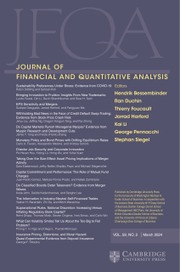No CrossRef data available.
Article contents
Firm Resiliency: The Role of Spillovers
Published online by Cambridge University Press: 23 January 2025
Abstract
Using high-frequency data on over 7 million import transactions, we study the disruptions to U.S. firms’ trade patterns and growth immediately following the initial COVID-19 trade shock. While large firms were not direct recipients of government fiscal support, they experienced fewer disruptions when located in counties where small businesses (SMEs) received government stimulus loans under the Paycheck Protection Program. These effects were largest in counties with greater share of SMEs and stronger input–output linkages between large firms and SMEs. Our results point to local spillovers between SMEs and large firms as being an important determinant of firm resiliency during crises.
Information
- Type
- Research Article
- Information
- Creative Commons
- This is an Open Access article, distributed under the terms of the Creative Commons Attribution licence (http://creativecommons.org/licenses/by/4.0), which permits unrestricted re-use, distribution and reproduction, provided the original article is properly cited.
- Copyright
- © The Author(s), 2025. Published by Cambridge University Press on behalf of the Michael G. Foster School of Business, University of Washington
Footnotes
We thank Senay Agca, Anne Helene Beck, Vineet Bhagwat, Juan Pablo Chauvin, Michael Faulkender, Noel Maurer, Anu Phene, Jennifer Spencer, Rob Weiner, and seminar participants at George Washington University, Peking University, Temple University, 2021 meetings of the UEA, 2022 Midwest Trade Meetings, and 2023 WAITS for helpful comments and suggestions. All errors are our own.

